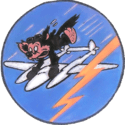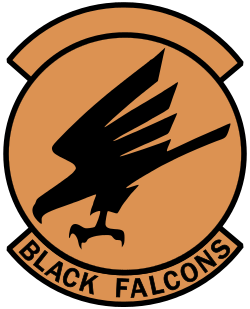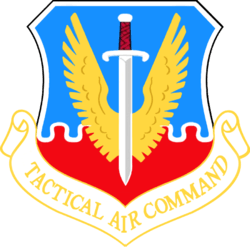429th Electronic Combat Squadron
| 429th Electronic Combat Squadron | |
|---|---|
|
Emblem of the 429th Electronic Combat Squadron | |
| Active | 1943-1998 |
| Country | United States |
| Branch | United States Air Force |






The 429th Electronic Combat Squadron is an inactive United States Air Force unit. It was last assigned to the 27th Operations Group and stationed at Cannon AFB, New Mexico.
The squadron was the last USAF unit to fly the General Dynamics F-111.
History
World War II
Activated in August 1943 as a P-38 Lightning fighter squadron under IV Fighter Command in Southern California. Trained with the fighter over the Mojave Desert, moving to the European Theater of Operations (ETO), being assigned to Ninth Air Force in England during March 1944.
Engaged in combat operations beginning in April, making low level sweeps over Occupied France, attacking enemy transportation targets and military convoys, bridges, armor formations and airfields. During D-Day, the squadron flew patrols over the invasion fleet. Remained in England after D-Day until August, moving to France and primarily provided ground-air support to the United States First Army in Northern France. Moved to Occupied Germany at the end of the war, becoming part of the United States Air Forces in Europe army of occupation during the summer of 1945.
Personnel demobilized in Europe during 1945, returned to the United States in November as an administrative unit and was inactivated without personnel or equipment.
Cold War
Reactivated in Japan under Far East Air Forces, July 1952 as a result of the Korean War. Replaced Federalized Georgia Air National Guard personnel, receiving their F-84G Thunderjets. Moved to South Korea in August, engaging in combat operations from Kunsan Air Base (K-8). From Kunsan the squadron bombed and strafed bridges, bunkers, troop concentrations, artillery positions, and a host of other enemy targets
Moved to Taegu Air Base (K-2) in April 1953 being attached to the 58th Fighter Bomber Wing. Flew interdiction and close air support missions in as well as attacking special strategic targets such as military schools, dams, and port facilities in North Korea until the June 1953 Armistice, Remained in South Korea for over a year afterward to insure Communist compliance with the cease-fire.
Returned to Clovis AFB, New Mexico in November 1954. Squadron was re-equipped with F-86H Sabre fighter-bomber aircraft, being assigned to Twelfth Air Force, Tactical Air Command. Maintained proficiency in tactical fighter operations, deploying components, aircraft, and crews on a global basis in support of NATO, PACAF, AAC, and other organizations. Deployed to southeastern United States during the Cuban Missile Crisis of 1962.
Reassigned to Nellis AFB, Nevada in 1966, becoming one of the first General Dynamics F-111A squadrons. Deployed aircraft to South Vietnam in early 1968, while still in training status at Nellis. Aircraft returned and development of the F-111 continued, finally reaching operational status in 1971.
Returned to Takhli RTAFB, Thailand in early 1972 as a result of the North Vietnamese Easter Offensive. Fully engaged in combat over North and South Vietnam for the balance of 1972, flying operations in good and bad weather when other squadrons were grounded. Flew approximately 4000 combat missions with excellent success rates in hitting targets even when visibility was near zero. Returned to the United States in March 1973, leaving its assigned aircraft at Takhli.
Almost immediately upon the squadron's return to Nellis AFB, was reassigned to the 347th Fighter Wing and deployed back to Takhli RTAFB, this time being placed on permanent party status in Thailand, taking over the aircraft it had left upon its return to the United States. For a brief two-week period the 347th flew combat operations into Cambodia until 15 August, when the last wartime mission of the Vietnam Era was flown into Cambodia for final mission of Constant Guard. After the cease-fire, the wing was maintained in a combat-ready status for possible contingency
After the end of combat missions in Indochina, the squadron moved to Korat RTAFB, Thailand in 1974 after the closure of Taklhi and remained in Southeast Asia through May 1975 to undertake strike missions in the event of further contingency operations. Participated in numerous exercises and firepower demonstrations, and, during Jan–May 1975, flew sea surveillance missions. Participated in the recovery of the American merchantman SS Mayaguez from Cambodian Communist forces in May 1975.
Upon return to the United States, reassigned back to the 474th TFW, sending F-111s to 366th TFW at Mountain Home AFB, and changing equipment to the F-4D Phantom II during "Operation Ready Switch". Received new Block 1/5 F-16A/B Fighting Falcon aircraft in November 1980 after protractive development period in the 1970s. Conducted routine Tactical Air Command training and deployments from Nellis with the F-16s, upgrading to Block 10/15 models in the early 1980s. Inactivated September 1989 when aircraft were considered no longer front-line combat capable.
Modern era
Reactivated in 1992 at Mountain Home AFB, Idaho, equipped with the new EF-111A Raven Electronic Warfare aircraft. Reassigned to Cannon AFB, New Mexico in 1993, taking over the aircraft of the 430th Electronic Combat Squadron when the EF-111 fleet was consolidated there. Engaged in operations with the Raven during the 1990s, as the only Raven unit in the Air Force.
The squadron flew Electronic Warfare jamming missions over the Balkans and Iraq, with 2,780 days and 32 rotations of continuous support of Operation Southern Watch. The United States Air Force officially retired the EF-111A in June 1998, and as a result of the retirement, the 429th Electronic Combat Squadron was inactivated June 19, 1998 - the last USAF F-111s being retired to AMARC.
Lineage
- Constituted 429th Fighter Squadron on 26 May 1943
- Activated on 1 Aug 1943
- Inactivated on 7 Dec 1945.
- Re-designated 429th Fighter-Bomber Squadron on 25 Jun 1952
- Activated on 10 Jul 1952
- Re-designated 429th Tactical Fighter Squadron on 1 Jul 1958
- Inactivated 15 November 1966
- Re-activated 15 September 1968
- Inactivated 30 September 1989
- Re-Designated 429th Electronic Combat Squadron 1 August 1992
- Activated on 11 September 1992
- Inactivated on 19 June 1998
Assignments
- 474th Fighter Group, 1 Aug 1943-7 Dec 1945
- 474th Fighter-Bomber Group, 10 Jul 1952-22 November 1954
- Attached to 58th Fighter-Bomber Wing, 1 Apr 1953-22 Nov 1954
- 474th Fighter-Bomber Group, 13 Dec 1954 – 1 Jul 1958
- Attached to 474th Fighter-Bomber Wing 8 Oct 1957-1 Jul 1958
- 474th Fighter-Bomber (later Tactical Fighter) Wing, 1 Jul 1958–15 Nov 1966; 15 Sep 1968—30 July 1973
- 347th Tactical Fighter Wing, 30 Jul 1973-21 Jun 1975
- 474th Tactical Fighter Wing, 21 Jun 1975-30 Sep 1989
- 366th Operations Group, 11 Sep 1992-22 Jun 1993
- 27th Operations Group, 22 Jun 1993-19 Jun 1998
Stations
|
|
Aircraft
|
|
References
![]() This article incorporates public domain material from the Air Force Historical Research Agency website http://www.afhra.af.mil/.
This article incorporates public domain material from the Air Force Historical Research Agency website http://www.afhra.af.mil/.
- Ravenstein, Charles A. (1984). Air Force Combat Wings Lineage and Honors Histories 1947–1977. Maxwell AFB, Alabama: Office of Air Force History. ISBN 0-912799-12-9.



